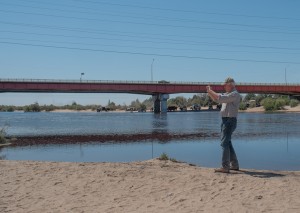The Imperial Irrigation District earlier this month threw down a significant marker in the ongoing struggle to deal back overuse of Colorado River water with a petition to the California State Water Resources Control Board demanding action on restoration of the Salton Sea.
The sea’s decline is one of the knock-on effects of efforts to untangle an over-allocation of the river’s water, and it is arguably the most difficult to solve. Everyone’s easy answer to bringing consumption and supply into balance (“easy” being a relative term here) is to move water out from southeastern California ag (primarily Imperial) to the urbanized L.A.-San Diego strip. But the Salton Sea, an accident of history that now lives on ag runoff, will inevitably suffer as a result.
There are two big concerns – air pollution from the drying playa, and loss of critical habitat, especially for birds.
Imperial’s argument in its SWRCB petition (pdf here, and worth reading if you have the time and want to understand the arcane details of the problem) is that when California water leaders approved a sweeping agreement in the early 2000s (the “Quantification Settlement Agreement,” known as QSA) to reduce the state’s Colorado River water by moving ag water to cities, dealing with the Salton Sea was part of the deal. IID argues that it’s been holding up its end of the deal, developing the institutional tools to move ag water to the coast, but that the state has not lived up to its obligation in return to come up with a plan for the Salton Sea. The canned press statement from IID board president Jim Hanks says it all:
“The mitigation water delivered to the sea under the original state board order ends in 2017,” said IID board President Jim Hanks, “and the state is no closer to implementing a restoration plan today than it was in 2003. IID and its urban partners have met all their water transfer milestones and stand ready to continue doing so in the future, but the state’s failure to act, along with an already-receding shoreline and the looming deadline of 2017 pose a direct threat to not only the residents of the Imperial and Coachella valleys but to the long-term viability of the QSA.” (emphasis added)
IID is asking the SWRCB to force the state to get serious, suggesting some very clear process steps for near-term action. And that last little bit, which I highlighted, suggests the threat. Here’s the language from the petition, with emphasis from the original:
[I]f the QSA is to continue – as IID believes it should – it must continue in its entirety, including through the State’s commitment to restore the Salton Sea.
The QSA is critical to California living within its 4.4 million acre foot per year Colorado River allocation.
Ian James’s Desert Sun story makes clear what is at stake here:
IID officials said the petition is aimed at keeping the water transfer deal in force. They said that while the water transfer is clearly needed during the drought, it’s also crucial to avoid a public health crisis as the lake recedes.
“This is being interpreted by some as a provocative act, and I want to be very clear that our intention at IID is to uphold the QSA, not to upend it,” Kelley said. “We’re very mindful of the deepening drought in California and the continuing drought on the Colorado River, so this situation at the Salton Sea, if it isn’t addressed, it doesn’t just threaten the residents of the Imperial and Coachella valleys. It has a bearing on the viability of these water transfers that are so important to the state.”



